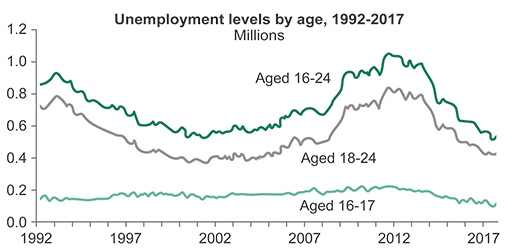6.2 Not in education, employment or training?
If the previous activity was concerned with those young people who rarely feature in social research and social policy, this last activity returns to more conventional subjects: young people whose wellbeing appears to be ‘at risk’, or who are seen to present risks to society because they are not engaged in any of the conventional avenues of adolescent progression – school or college, waged work or training. They are referred to as ‘NEETs’ because they are ‘Not in Education, Employment or Training’.
As children become young people and seek more autonomy for themselves, they may face growing risks of poverty and material deprivation. According to Daniel Sage (2016), almost a third of people (32.6%) in the UK aged under 18 were at risk of poverty or social exclusion, while 10.5% were experiencing material deprivation. By contrast, the corresponding figures for older people were 18.1% and 1.9% (Social Justice Index (SJI), 2015, cited in Sage, 2016). Tens of thousands of young people will fail to receive the kind of support they need to get into the labour market.
The number of unemployed young people has fallen from the peak levels of 2012 (see Figure 5 below), and although the proportion of young people as a percentage of the general population has been falling for some time, the proportion of young people (aged 16–24) who are unemployed has also fallen from 13.1% in November 2016 to 11.9% in Nov 2017 (House of Commons Library, 2018a). By comparison, in 2016, the unemployment rate for all those aged 16 and above was just 5%, suggesting that unemployment is a much bigger problem for young people than for anybody else. Unemployment is a particularly acute problem for young black people – over the period from December 2015 to February 2016, the unemployment rate among black 16–24-year-olds was 27.5%, more than double the rate for young white people (Unison, 2016).
Some of the challenging circumstances faced by young people are examined in the next activity.
Activity 7 Not so Nice and NEET
a.
making successful transitions to adulthood
b.
their overall wellbeing
c.
their average lifetime income
d.
avoiding criminal pathways
The correct answer is a.
a.
bleak and alienating
b.
a lot of laughs
c.
worth a lot of money
d.
unskilled and unending
The correct answer is a.
a.
disordered or suspended
b.
clearly signposted
c.
smoother and more enriching
d.
a career opportunity for moral entrepreneurs
The correct answer is a.
a.
Over half
b.
About one third
c.
Less than a quarter
d.
Does anybody care?
The correct answer is a.
a.
1996
b.
1949
c.
1968
d.
1918
The correct answer is a.
a.
Depression, isolation, anxiety and over-eating.
b.
Chronic fatigue syndrome, intolerance, nail biting and anxiety.
c.
Amnesia, depression, teenage angst and total torpor disorder.
d.
Nail biting, intolerance, chronic fatigue syndrome, isolation and over-eating.
The correct answer is a.
a.
little or no advantage when seeking employment
b.
significantly reduced self-esteem
c.
a higher than average elementary qualification
d.
several formatted certificates of general worthiness
The correct answer is a.
a.
Kite-marked partnerships between local authorities, employers and education institutions.
b.
Adult minimum pay.
c.
More funding.
d.
More youth centres.
The correct answer is a.
a.
the most vulnerable
b.
the hard to reach
c.
the right age group
d.
those more at risk of harm
The correct answer is a.
a.
Driving up labour market standards
b.
Fixed training budgets.
c.
Making things better for everybody.
d.
A Charter for Youth.
The correct answer is a.
Using the report, create your own summary document of the key points. This summary should be approximately 400 words, and might consist of a series of briefly-annotated bullet points. Preparing this document will involve developing skills in sifting and sorting information as well as presentation skills, and it will help you to engage more fully in the analysis presented in the report.
Discussion
The Youth Resolution report proposes a variety of challenging initiatives for government. The report’s approach is to shift the focus from the personal and individual deficiencies of young people towards a more structural method of addressing young people’s predicaments.
Increasing numbers of young people find themselves in precarious economic circumstances in which it is very difficult for them to fend for themselves, thrive and flourish. They may be seen to pose more of a threat to society than a symbol of its failures. When this happens, the policing of young people becomes an urgent priority for government.

